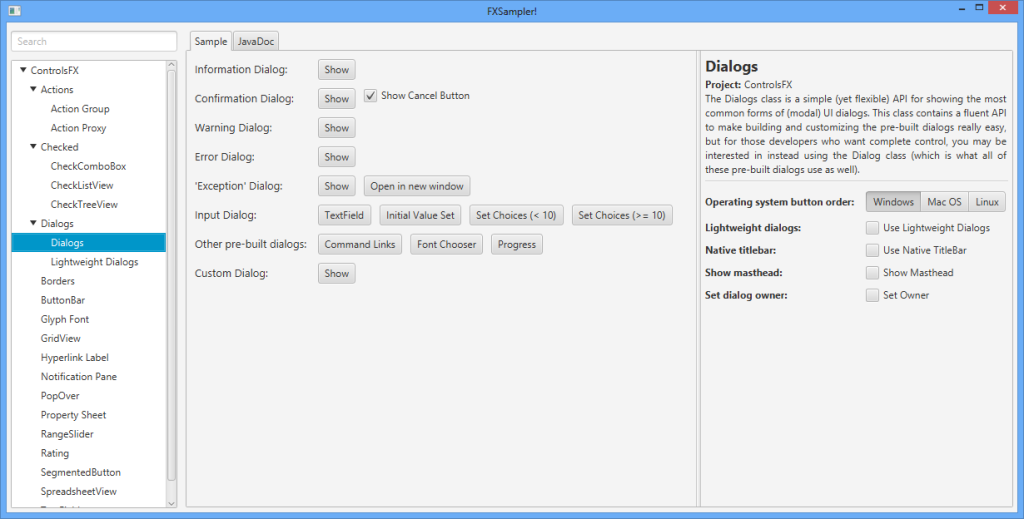FX Experience Has Gone Read-Only
I've been maintaining FX Experience for a really long time now, and I love hearing from people who enjoy my weekly links roundup. One thing I've noticed recently is that maintaining two sites (FX Experience and JonathanGiles.net) takes more time than ideal, and splits the audience up. Therefore, FX Experience will become read-only for new blog posts, but weekly posts will continue to be published on JonathanGiles.net. If you follow @FXExperience on Twitter, I suggest you also follow @JonathanGiles. This is not the end - just a consolidation of my online presence to make my life a little easier!
tl;dr: Follow me on Twitter and check for the latest news on JonathanGiles.net.
by Jonathan Giles | Dec 15, 2013 | Links
Another week, another bunch of links. Enjoy 🙂
- Hendrik Ebbers has collected together in one blog post links to all JavaFX-related talks at JavaOne 2013. If you missed a session (or didn’t go to JavaOne), then this is an invaluable resource. I’m slowly working my way through the sessions.
- This week JavaFX on iOS got a boost with the availability of tooling in NetBeans to help make the creation and packaging of iOS projects much simpler. This project makes use of RoboVM.
- Pedro Duque Vieira has created an ErasableTextField control which shows a clear button when text is entered, and he has also styled it to appear as expected in his JMetro project. In a separate post, he has also given a DateAxis and XYBarChart update.
- Sven Ruppert has posted an overview of Adam Bien’s afterburner.fx MVP framework.
- Speaking of MVP frameworks / dependency injection, Jens Deters has blogged about his own investigations into this area. From his post: “Finally I merged ideas from Adam (convention over configuration) and Alex & Co. (CDI) and modified them for my needs. I tried to keep the API as simple as possible and to reduce overhead to a minimum.”
- Speaking of application frameworks (again!), Sébastien Bordes has announced that JRebirth 0.7.6 has been released this week. It brings some threading improvements and add a default JavaFX preloader with some basic API enhancement.
- And to round the whole app framework links off, Sébastien Bordes has offered his opinion on CDI vs JRebirth.
- TestFX 3.0.0 has been released. TestFX is an easy-to-use library for testing JavaFX. TestFX provides a fluent and clean API for interacting with, and verifying the behavior of, JavaFX applications. This releases includes JavaFX 8 support and removes the need to fork the JVM between tests.
- Tomas Mikula has announced InhiBeans. As he puts it, “When there is a network of bound values, it often happens that a single user action on one end of the network results in a succession of changes of a value on the other end of the network. Most of the time redundant invalidation and change events do not cause problems, but they can come with a performance penalty if the attached listeners eagerly perform expensive computations. InhiBeans help inhibit this invalidation madness.”
- Christoph Nahr has released version 1.2 of his MIME Browser offline email reader client.
- If you’re interested in using JavaFX but would rather program in Scala, today is your lucky day as jpsacha has ported the Pro JavaFX Platform book examples to ScalaFX.
- Sai Pradeep Dandem has released a PatternLock control for JavaFX, for use when unlocking a mobile device by dragging your finger across a 3×3 grid to create a pattern.
That’s all for this week. Catch you again next week 🙂
by Jonathan Giles | Dec 8, 2013 | Links
Hi all – welcome to another weeks worth of Java desktop links! Enjoy 🙂
- This week Scene Builder 2.0 was open sourced as part of the OpenJFX project. This means that it is now possible for people to learn from the Scene Builder code base, and who knows, maybe propose improvements.
- Speaking of Scene Builder, Sven Reimers has two posts (so far) about embedding JavaFX Scene Builder 2.0 ea in NetBeans. The first post covers embedding the FXML visual renderer, and the second post covers embedding the hierarchy viewer.
- Tom Schindl has a blog post introducing his new project: SWT running on top of JavaFX. As he says in the post, “SWT on FX is an SWT implementation which instead of using the native widget it use JavaFX controls under the covers (similar to what SWT on Swing did some years ago).” At present it is more of a research project and is not yet available, although Tom is looking for expressions of interest in the technology so that he can develop a business plan around it.
- ControlsFX 8.0.3 was released this week, including a new PopOver control, new CheckComboBox/CheckListView/CheckTreeView controls, a new Borders API and a number of updates to SpreadsheetView. Also, the sample application was made more generic to allow for third party projects (such as JFXtras) to make use of it rather than have to develop their own sample application. Other users are more than welcome to use it as the base for their own application.
- Jens Deters has set up a website for his JavaFX projects (including adm4ee, a “management tool to ease the daily business of Java EE Application Server admins”, and FontAwesomeFX).
- Gerrit Grunwald has announced that his Enzo project has moved from Github to Bitbucket, and that the build structure has been cleaned up.
- Bertrand Goetzmann has announced PlantUMLFX, which is “a JavaFX 2 application implemented with a single GroovyFX script,
PlantUMLFX.groovy, that allows you to generate UML diagrams with the help of PlantUML.”
- The tomoTaka blog has a post about how to add drag and drop support for files being dropped on to a JavaFX TreeView control.
- Sean Phillips has a post rebutting an earlier blog post by Yakov Fain arguing about whether Swing should be killed to force JavaFX usage?
Catch you all next week!

by Jonathan Giles | Dec 4, 2013 | ControlsFX
I am incredibly pleased to announce on behalf of the entire ControlsFX team that ControlsFX 8.0.3 is now ready for download! This release comes approximately two months after the 8.0.2 release, and is a major release. For those too impatient to read the details, go here to download the release (or as always it is also available via Maven Central – just update your dependencies to 8.0.3). For those unfamiliar with the features of ControlsFX, refer to the features page. With that out of the way, let’s get into the juicy details of this release! 🙂
Firstly, it goes without saying that this release was a team effort, including input from the following people: Eugene Ryzhikov, Samir Hadzic, Henri Biestro, Dirk Lemmermann, Tomas Mikula, ‘Badisi’, Jean-François Henrard, and Danno Ferrin. It is due to these fine folks hard work that we have this release today!
Secondly, the reason why this release is two months in the making rather than the usual one month cycle is that we decided to improve the ControlsFX sampler program. It is now more generic (it is a totally separate application now), and because of this we are able to support other third party JavaFX projects. What this means is that other projects (such as JFXtras, for example) can now use the FXSampler app to demonstrate their own features, which saves them from having to write their own sample app. The ControlsFX team is more than happy to help other third party projects to make use of the FXSampler framework, just reach out to us in our Google groups. As of now the JFXtras team is already in the process of porting their samples to use this new framework.
(more…)
by Jonathan Giles | Dec 1, 2013 | Links
A very quick post today as I’m running out the door, but needless to say there are a bunch of good links and I hope you enjoy them as much as I did! 🙂
Catch you next week!
by Jonathan Giles | Nov 24, 2013 | Links
Wow! This week is by far the best week of links in a long time (sorry past weeks, but once you read through here I’m sure you’ll agree). There is so much going on now with Java on the desktop, and now on mobile platforms too (maybe these blog posts will need a name change soon) 🙂 I won’t spoil all the good details, but it is great to see things like professional services springing up for open source projects, blog posts from the likes of Intel and NASA, all the interesting progress on open source projects, and of course the progress towards getting JavaFX running on mobile platforms
- Johan Vos blogged that the DataFX project has a new release, along with a new website and Google group for discussions. Also, importantly, DataFX now has professional services available for teams that are using it and want support. I highly recommend you consider engaging the DataFX professional services as you’ll be learning from the experts (of both JavaFX and Java EE), and hopefully it’ll be mutually beneficial and will allow DataFX to become even more fully-featured.
- Dirk Lemmermann has blogged about a new ‘Popup Editor’ control he has developed. Funnily enough the ControlsFX team was planning on developing exactly the same component for the next ControlsFX release, but fortunately Dirk reached out to offer to contribute it to ControlsFX, and now it should appear in the 8.0.3 release in early December (all things going to plan).
- Mark Heckler has blogged about MonologFX, his custom dialogs API for JavaFX. He has introduced a new timed dialog feature which fades the dialog in and out.
- The JavaFX Prague team has a blog on building JavaFX for Android with the skia library (instead of statically linking in freetype).
- Speaking about running on mobile platforms, Tobi from UltraMixer Digital Audio Solutions has a blog post showing his software running on Android and iOS devices. Hopefully we’ll see contributions back into the JavaFX ports project that is gaining steam (and has a new Google group for discussions).
- Dustin Marx has posted about native Java packaging with NetBeans 7.4.
- Michael has posted a Gradle project for automatic OpenJDK/OpenJFX builds. Very nice! 🙂
- Intel have a detailed article about using JavaFX to implement multi-touch with Java on Windows 8 Desktop.
- Bertrand Goetzmann has a blog post up about TiddlyWikiFX, which is a JavaFX-based application that embeds a TiddlyWiki instance inside of it. It’s nice to see it making use of other open source projects: (obviously) TiddlyWiki, but from the JavaFX world it includes the afterburner.fx MVP framework as well as ControlsFX.
- Sean Phillips has posted part two of his series on visualizing NASA ground system data products using JavaFX and the NetBeans Platform.
- Pedro Duque Vieira has styled the JavaFX ComboBox control to take the Windows Metro look this week (as part of his JMetro project).
- Christoph Nahr has a blog post pointing out some flaws with the JavaFX ListView control. ListView is something I am responsible for, so I will be returning to this blog post myself in the coming days to work out what (if anything) needs fixing.
- Björn has a brief blog post about the 5.0 release of CaptainCasa, which includes full support for a JavaFX front end.
- Johannes Rupprecht has a post about nested or dependent JavaFX properties.
I hope you agree, a good week of links! Catch you all next week, and keep up the great work everyone! 🙂



